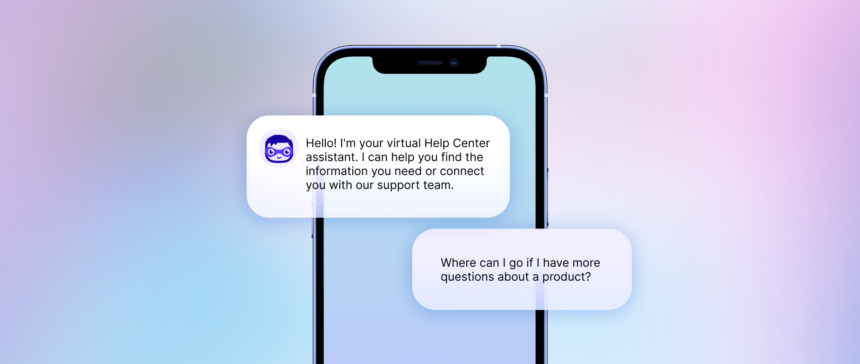The latest innovation in chatbots and artificial intelligence can help ecommerce business owners improve customer satisfaction and save time through automation. Yet, even for tech-savvy ecommerce entrepreneurs, navigating and implementing AI technology can be challenging.
It helps to start by learning the difference between two of the most useful types of ecommerce customer service tools for your business: a rule-based chatbot versus conversational AI solutions. Although they vary in ability and complexity, either type of chatbot technology can help your business more efficiently support customers—particularly when you use chatbots as part of a support ecosystem that includes human-powered customer service and FAQ pages.
In this guide, you’ll get a crash course in the differences and common use cases of rule-based chatbots and conversational AI-powered customer service tools. Equipped with this knowledge, you’ll be more prepared to make informed decisions about which automation tools are best for your ecommerce customer service strategy.
What is a chatbot?
A chatbot (or conversation bot) is a type of computer program that can imitate human conversations and generate content to suit a variety of business needs. Chatbot abilities vary depending on the type of automation technology used to create each tool.
This guide focuses on two chatbot categories: rule-based chatbots and conversational AI-powered chatbots. Essentially, you can think of rule-based chatbots as rule-abiding virtual assistants that only react in the ways you’ve ordered them to react in a given situation. As for chatbots powered by conversational AI, you can think of them as more sophisticated cousins of rule-based chatbots: They’re constantly processing new information, learning from it, and growing in their ability to handle a given situation—similar to how a quick-witted human might engage with it.
Popular applications of either type of chatbot in customer service include:
- Providing customers with information when they land on a brand’s website, social media, or messaging apps
- Handling direct customer interactions, such as requests for information about products, services, or company policies
What is conversational AI?
Conversational AI refers to any communication technology that uses natural language processing (NLP), deep learning, and machine learning to understand human language. Conversational AI systems can recognize vocal and text inputs, interpret language, and generate answers that successfully mimic human interactions.
Conversational AI technology powers AI chatbots, as well as AI writing tools and voice recognition technologies like voice assistants and smart speakers, which respond to voice commands. The conversational AI approach allows these tools to recognize user intent, follow the natural flow of a conversation, and provide unscripted answers based on the tool’s extensive knowledge database.
What is the difference between chatbots and conversational AI?
Chatbots are functional tools, while conversational AI is an underlying technology that may or may not be used to develop chatbots. Not all chatbots use conversational AI technology, and not every conversational AI platform is a chatbot.
In a customer service context, the two main types of chatbots you can use are rule-based chatbots and conversational AI-powered chatbots. Both types use conversational interfaces to handle customer interactions, like asking and answering questions. Both types of chatbots also function as virtual support agents, which helps businesses extend the capacity of their customer service teams.
The biggest difference between the two types of chatbots is the technology they use to respond to customer requests, which affects the complexity of the tasks they can accomplish. For example, rule-based chatbots can automate answers to simple questions that they’ve been programmed to handle, while conversational AI-powered chatbots can engage with a more expansive variety of inquiries because they’re continuously learning.
How do rule-based chatbots work?
Rule-based chatbots, sometimes called task-oriented chatbots, are a basic form of chatbot technology. The goal of these chatbots is to solve common issues by responding to user interactions according to a predetermined script.
To set up a rule-based chatbot for your business, you fill out an extensive conversation flow chart with a set of if/then conditions. Whenever a customer interacts with your chatbot, it matches user queries with the responses you’ve programmed.
For example, say the customers of your ecommerce business regularly seek help with the same three issues. Instead of fielding questions personally, you could install a rule-based chatbot on your website, and program the chatbot to provide those three most common support options for your customers:
1. “Help me place an order.”
2. “Track my shipment.”
3. “Connect me to an agent.”
From there, your customers can select one of those options or type a different question into a text field. If the customer chooses one of your pre-programmed options, then the rule-based chatbot will follow your corresponding automated script. If the customer chooses to type their own words into the text field, the chatbot will attempt to match the customer’s question with one of its predetermined conversation flows. For instance, say a user types in: “Why won’t my device turn on?” If you’d foreseen this question during set-up, the chatbot could respond with a pre-programmed troubleshooting conversation that aligns with the user’s language.
A rule-based chatbot is limited beyond what you’ve programmed it to say. For example, a rule-based chatbot can’t parse intent or respond helpfully to text inputs that deviate too far from the scripts you’ve programmed. That said, you can mitigate this issue somewhat by programming the chatbot to recognize language variants, such as “nope” as a variation on “no.”
How do conversational AI-powered chatbots work?
The capabilities of conversational AI-powered chatbots are more advanced than rule-based chatbots. You can get to the heart of why by considering this chatbot’s key qualifier: conversation. Thenatural language understanding capability of conversational AI chatbots enables them to hold human-like conversations with users. That means they can follow the natural flow of a conversation and pivot to meet a user’s changing needs. AI-powered chatbots do this by processing user language, understanding the intent of a question, and generating responses, without needing a provided script.
Since AI chatbots can answer more elaborate user questions and execute more complex tasks than a basic chatbot, ecommerce businesses can use these types of chatbots to support a wider range of sophisticated customer support functions.
For example, an AI-powered chatbot could assist customers in product selection and discovery in ways that a rule-based chatbot could not. A user might ask an AI chatbot to explain the difference between two products or to recommend a product based on specific parameters—such as a green swimsuit that costs less than $50 and is good for athletic activities. In response, the chatbot can provide recommendations, answer questions about the recommended products, and assist with placing the order.
As opposed to rule-based chatbots, AI-powered chatbots don’t rely solely on your pre-programmed scripts. Instead, AI chatbots improve customer satisfaction, thanks to their advanced conversational AI technology.
Product examples: Chatbot vs. conversational AI
Now that we have a better understanding of rule-based chatbots and conversational AI-powered chatbots, let’s take a look at a few product examples to further clarify the nuances between these types of technology.
ChatPion: A chatbot, but not conversational AI
ChatPion is a rule-based chatbot tool. Businesses pre-load conversational flows and the chatbot executes the flows with users. Because it doesn’t use AI technology, this chatbot can’t deviate from its predetermined script.
Grammarly: Conversational AI, but not a chatbot
Grammarly is a conversational AI platform that can understand human conversation and generate human-like written text, but it’s not a chatbot. Grammarly can help you write emails, but it can’t respond to customer service requests for your business.
ChatGPT: Both conversational AI and a chatbot
Open AI’s chatbot tool ChatGPT is a conversational AI chatbot that uses generative AI technology. It can interpret user questions and generate natural responses based on a large amount of source data. Instead of only using a predetermined chatbot script, ChatGPT’s creators trained the chatbot using the entire internet as its source information. As an AI chatbot, ChatGPT can facilitate conversational flow and continuously learns from user inputs.
Shopify Inbox and Sidekick (powered by Shopify Magic): Both conversational AI and a chatbot
Shopify Magic is a suite of ecommerce-driven AI tools for optimizing your online store. One of those tools is Shopify Inbox, an AI-powered chatbot that helps entrepreneurs automate their customer service interactions, without sacrificing quality. Inbox uses conversational AI to generate personalized answers to customer inquiries in your shop’s chat, which helps customers get the answers they need more efficiently. This feature can help you save time, improve customer experience, and even boost sales by turning more browsers into buyers. Sidekick is your AI-enabled ecommerce adviser that provides you with reports, information about shipping, and setting up your business so it can grow. It uses a traditional chat interface.
Use case example: A rule-based chatbot in customer service
Companies can use both conversational AI and rule-based chatbots to resolve customer requests efficiently and streamline the customer service experience.
Although rule-based chatbots are more limited than AI bots, they can still handle initial customer service conversations and funnel customers to the proper human agents. A rule-based chatbot can also walk a customer through a routine task, like initiating a return. That automation can improve a business’s customer experience by delivering immediate responses to common questions.
For example, an ecommerce apparel business can program a rule-based chatbot to start a conversation with, “How can I help you today?” and instruct it to respond to user queries that include the phrase “Start a return” or “Return” with, “I’m happy to help you initiate a return. Do you have your order number handy?”
From this point, the business can specify responses to “Yes” and “No,” such as giving the user information about where to find their order number or providing the link to initiate a return. If the user submits a query outside the scope of the rule-based chatbot’s conversation flow, the business can have the chatbot connect the user to a human agent.
Use case example: An AI chatbot in customer service
Since conversational AI solutions can handle more complex customer service requests and tasks, businesses can use conversational AI agents to support multiple points along the customer journey—from help selecting products to scheduling appointments.
For example, a cosmetics business might use a conversational AI application, such as Shopify Inbox, to help users find the best products that meet their needs.
In this case, users can ask the conversational AI chatbot a variety of specific questions, such as:
- What’s your best foundation for oily skin?
- Will this mascara run if I cry at my wedding?
- What’s a good red lipstick for olive skin tones?
Because the AI chatbot understands natural language, it can provide a helpful answer without requiring the business owner to anticipate each question and script a response in advance. These types of chatbots essentially function as virtual assistants for shoppers, automatically handling more complex customer service tasks with minimal need for human assistance.
Chatbot vs. conversational AI FAQ
What are the two types of chatbots?
The two types of chatbots are rule-based chatbots and AI-powered chatbots. Rule-based chatbots follow predetermined conversational flows to match user queries with scripted responses. AI-powered chatbots use natural language processing (NLP) technology to understand user inputs and generate unique responses informed by the tool’s extensive knowledge base.
What kind of AI is used in chatbots?
Rule-based chatbots do not use AI, but AI-powered chatbots use conversational AI technology. Conversational AI systems use natural language processing (NLP), deep learning, and machine learning to understand human inputs and provide human-like responses.
What are the benefits of using conversational AI in customer service?
Implementing AI technology can provide immediate answers to many customer questions, which can extend the capacity of your customer service team, reduce wait times, and improve customer satisfaction.







